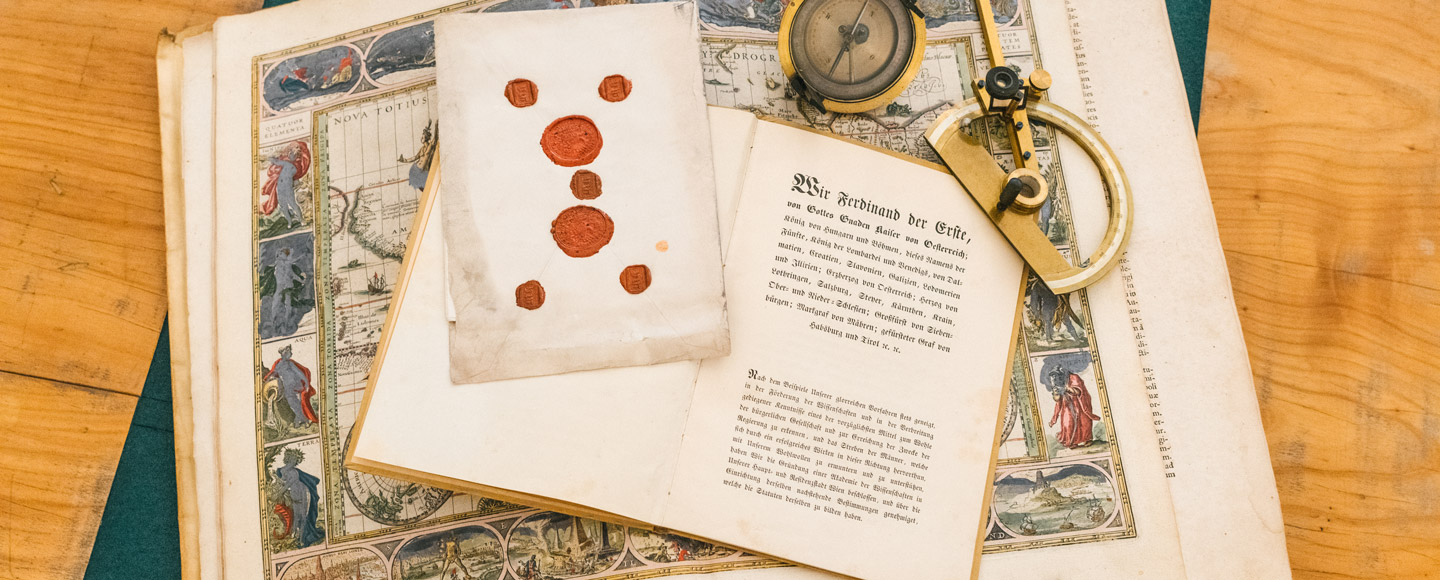
1847 – an academy is born
On 14 May 1847 Emperor Ferdinand I approved via a patent the founding of the Imperial Academy of Sciences in Vienna. The Orientalist Joseph Freiherr von Hammer-Purgstall was elected as its first president. From the outset the Academy undertook pioneering research of great importance to the state and increasingly on the international stage in the central fields of the arts and sciences. Many results were published in the memoranda of the Academy, which were open to all languages of the Habsburg Empire. In 1857 the Academy moved to the former premises of the University of Vienna on the Dr. Ignaz Seipel Platz, which had been used by the military since 1848 and which has remained the site of the Academy to this day.
The sciences awaken: expeditions and discoveries
From its very inception, the Academy’s central research tasks were the curation of Austrian historical sources, and, shortly after, the oldest Christian Latin autographs. Its activities were expanded by sensational excavations at Ephesus, Giza, biblical Shechem and other sites, and research on African, Asian and American languages and cultures.
The Academy maintained the first meteorological stations throughout the empire and initiated the establishment of the Central Institute for Meteorology and Earth Magnetism (1852). Members of the Academy undertook research on the Adriatic Sea and the oceans – and participated in the circumnavigation of the globe by the frigate “Novara” (1857–1859). The Academy published the scientific results of this voyage, just as it published the findings of the Austro-Hungarian expedition to the North Pole (1872–1874). The interdisciplinary “South Arabia expedition” (1898–1899) saw groundbreaking research on Yemen, previously unknown to western scholars, and the old castle of Caliph Walid II, Qsar Amra, was discovered in the North Arabian Desert.
The Academy and its internationally-oriented scholars crossed not only territorial, but also scientific and institutional boundaries, taking the first steps to founding an “International Association of Academies” (1899), the first federation of academies to unite institutions across different countries and even continents. The Association conducted collective research in the arts and natural sciences.
The establishment of the Phonogram Archive (1899), the world’s oldest audio recording archive, the first Institute for Radium Research (1908/10) and the takeover of the Institute for Biological Experiments (1914), one of the first institutes for experimental biology, were further decisive steps that raised the profile of the Academy of Sciences as the world’s leading research centre on the eve of the First World War.
Dark years: the end of the Monarchy, and National Socialism
Following the collapse of the Monarchy in 1918 the Academy fell into economic and scientific crisis: the “International Association of Academies” was not revived, the Academy of Sciences in Vienna (as it was now called) increasingly regarding itself as a “German” academy. The “annexation” of Austria into the National Socialist German Reich in March 1938 represented a profound caesura for the Academy; its management positions were filled by National Socialist factionists. Academy members – including Nobel Prize winners – were forced out of the Academy on political or “racial” grounds, members of staff were persecuted and expelled. Eight of its members and employees died in the National Socialist concentration camps.
From Life Sciences to Digital Humanities: research of international standing
The intellectual exodus and the half-hearted de-Nazification in the first two post-war decades led to significant stagnation that could only be overcome by an intensified re-internationalisation of the Academy. The establishment of pioneering new institutes in the late 1960s and early 1970s breathed new life into scholarship at a number of sites throughout Austria. Renamed the Austrian Academy of Sciences in 1947, during the Cold War it played an important role as a mediator in the politics of science between East and West.
Today, thanks to increasing international collaboration the OeAW once again plays a central role in the global research landscape. As Austria’s largest non-university research institution it conducts basic research in key fields – from Life Sciences to Mathematics, Physics and Materials Sciences, the Social Sciences, Cultural Studies, Antiquity and Historical Studies and the Digital Humanities. At the same time the OeAW and its members are keenly aware of their duty to grapple with questions concerning society and to lend their scientific expertise to the public sphere.